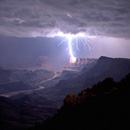Scientists Discover Antimatter In Storms On Earth
IFL Science
Wed May 13, 2015
Area: Boston (Manchester)
A team of high-flying scientists think they have discovered that pockets of antimatter exist within lightning storms.
Like most heavily dramatized scientific discoveries, there was a violent storm outside, and Joseph Dwyer's airplane was heading towards what he thought were radio signals coming from the coast of Georgia.
"Instead, it was a line of thunderstorms-and we were flying right through it," Dwyer, an atmospheric physicist from the University of New Hampshire (UNH), says. The plane was tossed around by the storm and then suddenly plunged downwards. "I really thought I was going to die."
In 2009, the flight had set out to search for gamma rays-extremely high-frequency electromagnetic radiation. During the tempest, the detector picked up three gamma radiation peaks that had an energy of 511 kiloelectronvolts. This is the signature energy of a positron and an electron annihilating to produce pure energy in the form of gamma rays.
Somehow, Dwyer's plane had detected signals that come from positrons: the antimatter versions of the electron. The positron has the same mass as the electron, but it has the opposite electric charge. It would seem, then, that the airplane had flown through a small cloud of antimatter.
"This was so strange that we sat on this observation for several years," Dwyer told Nature. The findings were finally presented at the American Geophysical Union's Fall Meeting in 2014.
Antimatter is very rare; it is destroyed when it comes into contact with ordinary matter, so it is not often that we detect it on Earth. Astronomers see it aplenty: belched out of black holes and spewed from space in cosmic rays. So it is understandable why the discovery that antimatter exists within comparatively mundane lighting storms on Earth seemed so peculiar to the scientists.
It is not completely understood what the mechanism responsible for these antiparticles is. One explanation is that electrons are spat out of the storm cloud at close to the speed of light. This high-energy electron can spit out two gamma rays in order to lose some energy. If these subsequent gamma rays hit an atomic nucleus, they turn from two energy waves into one matter and one antimatter particle-an electron and a positron. This process is quite long-winded and requires a lot of energy. There were a few gamma rays detected with enough energy to create positrons and electrons, but not enough for this theory to be compelling.
Another possibility is that the positrons fall to Earth carried by cosmic rays. The drizzle of positrons collide with the Earth's atmosphere and release high-energy gamma rays that are then somehow directed towards thunderstorms and the team's airplane. This suggestion is also unsatisfying since the positron drizzle would be accompanied by a cocktail of other radiation that the team just didn't see.
Dwyer is eager to find more positron readings within lighting storms. However, popping into the heart of the nearest thunderstorm to measure matter/antimatter particle emissions is not advisable. But that won't stop Dwyer; he plans on sending some little, inflatable minions into thunderstorms to do the brunt work on his behalf. He will attach detectors to balloons and release them into thunderstorms to see what they can detect-much less dangerous than risking human lives.





 Share your thoughts in the Forum
Share your thoughts in the Forum